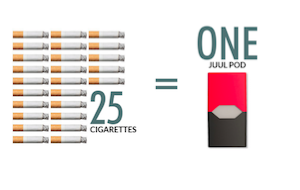Juul limits flavor selection, FDA cracks down
In recent years, gas stations around America transformed into nicotine candy stores. Among the E-cigarettes lining the shelves are Juuls, the most popular nicotine vape in 2017. There are mango, creme brulee, cool cucumber, and fruit medley flavors, next to more traditional ones including tobacco and menthol.
Following an FDA campaign against teenage vaping, Juul announced on Tuesday that it would end the sale of its mango, cucumber, fruit and creme flavors in convenience stores. Juul will also stop social media advertising.
Juul has been continuously criticized for a modern aesthetic and flavors that appeals to a younger audience.
“Our intent was never to have youth use Juul,” said Kevin Burns, chief executive of Juul Labs.
Since 2017, high schools have seen a 78 percent increase in vaping among high school students. 
Senior Jacobean Jones* started juuling November of her junior year. She doubts the ban will actually affect her or her peers.
“Most of my friends use mint and menthol because of the cooling sensation,” she said. “To a point, people [who use the other flavors] are going to be pissed off, and it might be a little bit of a deterrent, but in terms of the actual urge to consume nicotine, as long as mint and menthol are still available it’s not going to drive a complete quitting.”
Juul’s flavor purge came before FDA Commissioner Scott Gottlieb announced the decision to restrict the sale of flavored “electronic-delivery nicotine products,” exempting menthol and mint.
“I could take more aggressive steps,” Gottlieb said in a written statement. “I could propose eliminating any application enforcement discretion to any currently marketed ENDS product, which would result in the removal of ALL such products from the marketplace. At this time, I am not proposing this route, as I don’t want to foreclose opportunities for currently addicted adult smokers.”
For the very sake of the company’s survival, Juul needs to decrease youth consumption. In addition to eliminating certain flavors, Juul will also stop social media advertising on the basis that it appeals to minors.
Although Jones sees how marketing could contribute to the nicotine epidemic, ads weren’t what led her to juuling. She began juuling because she saw older peers using the nicotine vape.
“When you try to appeal to a young adult age group, you are also appealing to teenagers,” she said. “Teenagers want to be involved in all the things college kids are doing, so there isn’t much of a cognitive disparity within the two age groups in terms of what attracts them and what they think is cool.”
After almost a year of Juuling, and hundreds of dollars spent on pods, Jones is ready to give it up. But her reasons for quitting have nothing to do with the changes Juul is making, instead, she’s noticed the physical changes the addiction has caused her.
“If you go without it, your mood shifts,” she said. “My appetite has gone down a lot. Things like that worry me. It’s nice to have the feeling or the rush, but if you compare that to my overall well being I don’t really see the value.”
To truly end youth juuling, Jones believes that is the message Juul needs to show current users. If not, the cycle will continue.
“If they [FDA, Juul companies] are focusing on keeping kids from doing it in the first place than they are not focusing on the kids who are already doing it who have more of an effect on their peers and the kids younger than them,” Jones said. “Because the kids younger than them look up to them and see them doing it then they’re going to start doing it no matter what advertisement is put out, and not matter what flavors are put out.”
Graphics courtesy of Ava Posner
Contact the writer: [email protected]











